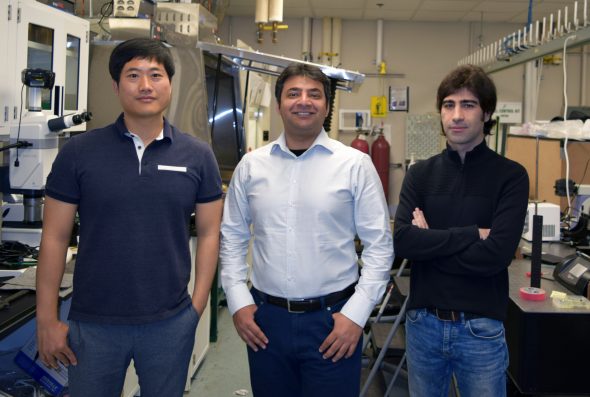Researchers create one of smallest nanoparticle stabilized nanoemulsions with new technique

From left: Postdoctoral student Dong Jin Kang; Sushant Anand, assistant professor of mechanical and industrial engineering; and Ph.D. student Hassan Bararnia.
Sushant Anand, assistant professor of mechanical and industrial engineering, and his research associates have had multiple breakthroughs with their work on oil-water mixtures or “emulsions.” Now, the researchers have taken their research to a new level by creating ultra-small (100-400 nm in sizes) nanoemulsions formed by self-assembly of nanoparticles around droplets.
The traditional way to make nanoemulsions has multiple steps, but Anand and his team have developed a single-step technique for creating nanoemulsions that is faster, more energy efficient and smaller. The results of the research were recently published in ACS Applied Materials and Interfaces journal under the title “Synthesizing Pickering Nanoemulsions by Vapor Condensation.”
“Nanotechnology has a huge role to play in dealing with many problems in today’s time. Take oil-water emulsions as an example,” Anand said. “Going ‘nano’ with droplet sizes can make huge difference in the shelf-life of many emulsion based products like cosmetics, food products, drug delivery and many multibillion dollar industries. Typically surfactant molecules are used to prevent drops from coming together. But such molecules can have adverse effects in many cases. So, there is a growing interest in making surfactant-free nanoparticle stabilized emulsions.”
The challenge the team faced was making nanoparticle-based, nano-droplet emulsions, which are called Pickering emulsions.
“Making such emulsions with droplets in nanoscales has been a really big challenge for many decades,” Anand said.
In a previous work published in Nature Communications, Anand and his collaborators at MIT previously showed that they could create nanoemulsions where the droplets were stabilized by surfactants. Anand and his students wondered whether the new technique could potentially be used to make Pickering nanoemulsions, so they went on to find that out.
“Emulsions can be made by many different ways, but unfortunately what works for surfactants, does not necessarily works with nanoparticles. So, there was no guarantee that we would succeed,” added Dong Jin Kang, a postdoc working under the direction of Anand. “But the new technique did succeed in meeting its objective.”
The process involves taking oil and cooling it down below the dew point so that water condenses on the oil. If the oil has the right properties and if it has sufficient concentration of nanoparticles, then the water drops will self-disperse within the oil and nanoparticles will self-assemble around them to make nanoemulsions.
“What we have shown with our work is that we have made one of the smallest nanoemulsions with nanoparticles,” said Anand, who is the director of the Anand Research Group laboratory at UIC. “What makes the whole thing exciting is that to make those emulsions in a traditional way, they had to undergo multiple steps. And they require a very high particle concentration to make small nanoemulsions. But we are able to make the emulsions in a couple of minutes and make them very small – 10 times less concentration than what previous people have tried to do.”
“Our technique is very scalable and can potentially be used on an industrial level. We have shown that it is highly energy efficient when compared to current techniques of making emulsions, and we were also able to provide a framework on the different factors that control the size of emulsions,” Anand added.
“This technique opens upon new gateways and opportunities – from making membranes to drug delivery applications,” said Hassan Bararnia, a Ph.D. student working with Anand.
“We can apply these emulsions into other fields and it can have an impact on many industries – the possibilities are immense. Right now we have used simple silica nanoparticles, but we can use different type of nanoparticles such as organic/inorganic core-shell nanoparticles,” added Kang.
Anand agrees. “The possibilities are there, but so are challenges and that is where all the excitement lies — in overcoming them!”
In a related work that has recently appeared in the journal Nanoscale, titled “Nanoparticle Synthesis Via Bubbling Vapor Precursors in Bulk Liquids,” Kang and Anand have developed a new way to make simple and complex nanoparticles.
“The key benefit of our technique is that we can make complex particles of uniform properties, in absence of any side-reactions and tune the shell-thickness around nanoparticles very nicely,” Anand said.
The work from Anand and his team is drawing attention from their peers in the science community around the world.
“The paper by Dr. Anand and co-workers on nanoemulsions stabilised by colloidal particles is very novel and timely,” said Dr. Bernard Binks, a professor of Physical Chemistry at University of Hull in the United Kingdom, and an expert on the subject of Pickering emulsions. “Comminution methods for breaking droplets into sub-micron ones have proved very challenging. This work starts from molecular water vapour and grows the droplets to defined sizes set partly by the particle concentration. It will be of great interest to colloid scientists and researchers in industry, too.”
Learn more about Professor Anand’s research at http://anand.lab.uic.edu.
